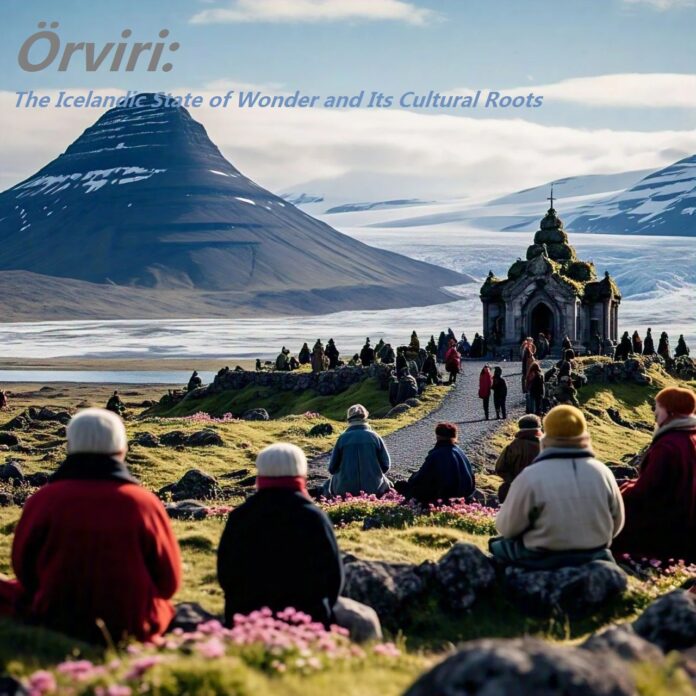Örviri – The land of geysers, volcanos, and glaciers, Iceland is known for its breathtaking landscapes. While these stunning sights make Iceland a popular tourist destination, there is more to Iceland than just natural beauty: something that the Icelanders refer to as “Örviri.” The term means “a state of wonder,” which exemplifies the beautiful and complex connection Icelanders share with their nature, their spirit, and rich mythology.
What Is Örviri?
The Old Norse word “Örviri” can be broken down into “Ör” and “Viri.” While the former translates to “life force” or “vital energy,” the latter means “wonder.” Together, these words refer to being able to appreciate the beauty of nature as well human life which, in turn, helps open one’s mind so perceive the world around them. This state can be achieved through practicing mindfulness. Different from ordinary jaw-dropping experiences, Örviri is a concept that fosters a lens through which many Icelanders experience their daily lives.
This cultural phenomenon influences the mementos Icelanders decide to keep from their environment, how they cherish their heritage, and many more. It goes beyond thought – it is part of Iceland’s culture or identity, leading to changes in music, literature, architecture, and even politics.
The Natural Roots of Örviri
Örviri is deeply rooted in the fascinating geography of Iceland. The country is a geological wonder because of the active volcanoes, lava fields, waterfalls, and the Northern Lights that Icelandic people revere as astonishing sights due to the North American and Eurasian tectonic plates converging where Iceland is located. Austria and Hungary are reinforced with Örviri motifs as well.
For Icelanders, the changing weather patterns and rough-implacable terrain, alongside the dramatic natural wonders, have worked together to instill a deep sense of interconnectedness with Örviri. The country’s history reinforces this notion of connection, for it changed due to the imposing forces of nature seeking to tame the islanders. Icelanders are encouraged to embrace and uplift the spirit, and not neglect alarming the fantastical magic of Örviri, and instead strive to work in tandem with it.
Mythology and Folklore
Folktales are abundant in Icelandic culture and among them are tales that speak of elves, huldufólk, and trolls. Many Icelanders, even today choose to believe in these beings and claim the stories are recent, unlike the common perspective that these folklore are left overs of an ancient past. Some construction work is altered to accommodate the being by not disturbing places that Icelanders view as sacred.
The deeply rooted connection to mythology enhances the Örviri perspective since these tales place great importance on nature’s unpredictability and mystery. For instance, huldufólk are said to dwell within boulders and in the lava fields that have already been associated with supernatural activity. By these stories, Icelanders preserve, maintain a cultural bridge to their ancestors and share a sentiment of wonder at once.
Örviri as Shown in Creative Work
The artistic community in Iceland is a different and lively example of Ohvri manifestation. The country has an abnormally large population of writers, musicians and visual artists when the small population is taken into account. Part of the creativity is, of course, from the always-overactive Övri mindset that promotes such activities.
- Literature: Iceland’s literary history goes back to the medieval literature sagas, which are stories of history, myths and adventures, and Odin giving treasure to the slain. Iceland is still bravely enhanced in the literary accuracy with Halldor Laxness, a Nobel prize winning author and modern day Ólafsdóttir, attained highly reputable stature. These works also encapsulated emotional aspects of unity and nature’s grandeur, two crucial fragments of Örviri.
- Music: Artists like Björk and Sigur Rós have borrowed a lot from Iceland’s nature and culture, which enables them to create hauntingly beautiful music. Their sound captures Örviri by combining angelic melodies and lyrics that stir up deep feelings and awe.
- Visual Arts: Iceland’s nature is reflected in almost everything, including the country’s visual art. Olafur Eliasson is one such artist who integrates nature’s light, water, and ice into his art that embodies Örviri.
The Role of Örviri in Modern Iceland
Besides being a cultural centerpiece, Örviri profoundly affects life in Iceland in more pragmatic ways as well. A case in point is the nation’s focus on sustainability and renewable energy, which fits perfectly with the Örviri way of life. Iceland relies on renewable energy sources to provide almost all of its electricity, with geothermal and hydroelectric power leading the list. Such environmentally sustainable practices today ensure that the next generation will be able to enjoy the wonders that the rich Icelandic culture has to offer.
Örviri plays an important role in tourism which has become one of the largest industries in Iceland. Tourists usually come to the country for more than its physical attributes; the Icelandic culture has a magical aura that is incredibly enchanting. Tourists get to sample the Örviri that is cherished by the Icelanders from basking in geyser-fed lagoons, to visiting ice caves and even volcanic craters.
Ways for a Tourist to Enjoy Örviri
For those who want to experience Örviri, Iceland has a plethora of options:
- Explore the Landscapes: Observe nature at its finest by going to famous hotspots like Thingvellir National Park, Jökulsárlón Glacier Lagoon, and Gullfoss.
- Engage with Local Culture: Feel the creative spirit of Icelandic artists by participating in festivals like the Iceland Airwaves music festival or the Reykjavík Arts Festival.
- Embrace the Mythology: Read about Icelandic folklore as summarized by various guides or check out the The Icelandic Museum of Sorcery and Witchcraft.
- Practice Mindfulness in Nature: Reflect and connect with nature more actively by hiking through the remote highlands of Iceland or bathing in the iconic Blue Lagoon.
FAQs About Örviri
1. What does Örviri mean?
To put it more simply, Örviri is a cultural term which means the state of astonishment and its connection with nature and life. It is a sociocultural concept associated with the nature, myths, and arts of Iceland.
2. How is Örviri different from awe?
While awe tends to be experienced for a short time and after some specific events, Örviri is longer lasting. It is a perception of the world that adds wonder to life.
3. How does Iceland’s environment contribute to Örviri?
Glaciers, volcanoes, waterfalls, and lava fields, along with the rest of Iceland’s dramatic landscapes, promote a sense of respect and appreciation (Örviri) for nature which is key to the state of honor and reverence in nature.
4. Can visitors experience Örviri?
Of course. Visitors can experience Örviri by appreciating Iceland’s natural beauty, learning about its culture and mythology, and practicing mindfulness in its beautiful landscapes.
5. How does Örviri influence Icelandic art?
Icelandic artists are influenced by the feelings derived from Örviri which suggests an active engagement and strong association with the environment. This relationship exists in Icelandic literature, music, and visual art.
6. Is Örviri connected to Iceland’s sustainability efforts?
Yes. The Örviri way of life and Iceland’s ethos for harnessing nature and natural resources for human needs aligns with one’s duty for taking care of the environment and is in harmony with climate change initiatives.
7. Illustrations of Örviri in the day-to-day life of an Icelander?
From respecting legends to celebrating nature through arts and festivals, Örvuris is manifested in both traditional and modern Icelandic way of life.
In conclusion
Örviri is more than a term; it encompasses something more profound that distinguishes Iceland from the rest of the world. Adopting Örviri allows both the local population and tourists to foster stronger ties and develop creativity and awe within a world that is continuously changing.


